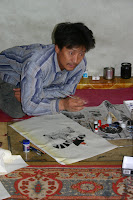



Inside the fence there was a yard of around twenty or so square meters. Gannbaatar led us into the house, divided by a white wall with peeling-off paint. On the left side of the wall was a small kitchen with an ancient-looking agar rusted with age. On the other side was the ten-square-meter lounge-bedroom in which all his family – Ganbaatar and his wife, their five children and two grandchildren – eat, drink and sleep.
Ganbaatar and his wife Altantsetseg (meaning ‘rose’) opened their arms to us. ‘Come inside!’ they said. She has a kind face and distinctly high cheekbones. She was holding her one-year-old granddaughter Baika in her arms. She asked me to call her Alta.
Inside the carpet-filled lounge-bedroom, there are two single beds on the side. Alta tugged her granddaughter inside the woolen cover and put her to a nap.
Ganbaatar laid out all his work on the floor to show us. With a cup of tsai (tea), we indulged ourselves glancing through all of his paintings like in a gallery. I particularly had my eyes on a painting in the same style as ‘One Day in the Life of Mongolia’ as he promised.
‘This is what you’re looking for,’ he said. Urnaa and Arghun were giggling and making fun of the details of love making and toileting in the painting.
‘These are just routine functions in everyone’s life,’ Ganbaatar said to them, ‘They are very natural things in Mongolian art.’ He’s quite right – and the Mongolian artists don’t have a hang-up about such things.
‘Once, I sold a copy of this painting to an American, for $1,500,’ he told me.
‘I have never been to an art school,’ he told me, ‘I admired other people’s work, and so I taught myself to draw, from reading art books and doing sketches at first. And then I started painting in water colour. Occasionally I also did oil paints. Over the past twenty years, I’ve come to acquire the skills.’
Ganbaatar is among a few hundreds of street artists trying to make a living in Ulaanbaatar. The trade relies a great deal on tourists and international visitors. Tourism is, after all, a large part of the country’s means of livelihood – it accounts for 18% of the economy. Despite so, tourism only really functions three months a year because of the climate – the severely cold winter with temperature dropping down to 40 centigrade’s is practically the zero season for tourism.
Therefore, the work of the street artists is very much seasonal. They need to make good use of the short time they have in a year to sell their work. In the winter, they would prepare and get their work ready. Once the summer comes and brings back tourists, they would all pour into the streets all over the city. In one day, a street artist would need to walk for miles to search for buyers. They move from spot to spot, from the busy shopping streets to the bars, and to the museums and galleries.
During the off-peak seasons, Ganbaatar makes a living by working as a driver for private companies. Alta works at home, looking after the kids and grandkids, which is more than a full-time job. Despite their dignified appearance, I get the impression that they are struggling hard to make ends meet.
Ganbaatar decided to complete a drawing for me while we were there. We all sat on the beds watching him, while he bent on his knees, lay out the paper on the floor, and mix in the paints carefully. He had not even a canvas to draw on. ‘I did have a studio once,’ he looked up and told me.
The dim light from the shade-less light bulb shone through from the kitchen. His brushes looked as old as his ink. Perhaps he couldn’t really afford to invest on his means of production. He focused on each stroke of his, frowning occasionally as if discontent with what he’d done. He looked like he was completely in his own world.
Alta sat leaning against a huge pile of five or six suitcases, as if the family has only arrived here. She told me that they’ve always lived here. She watched her husband with apprehension, as if he might soon make a wrong stroke on the thin paper. She looked tired, with bits of her hair hanging down her cheeks. This was probably one of the rare moments when her granddaughter’s taking a nap and she could have a little break.
Ganbaatar offered to take us to visit his brother who’s living next door in a ger inside the fence. It is a small ger with not much furniture inside apart from two beds. ‘This is my brother,’ Ganbaatar introduced me to a man sitting on the bed. When I met his sister-in-law Tsegii in London months later, she explained to me that the man in the ger is in fact the brother-in-law of Ganbaatar’s brother. Such distant relative – Tsegii said that Mongolian people tend to call all relatives “brother” or “sister” when introducing them.
Although these two families are living right next to each other, they seemed to maintain quite independent in their life. They don’t even cook or have dinner together.
‘A ger like this costs $1,500 to build,’ Ganbaatar told me. This is double the price of a ger from what I knew back in 2002.




No comments:
Post a Comment